As part of our ongoing efforts to keep the industry connected during these challenging times, FTE staged its first live virtual event focusing on Post-COVID-19 Airports, which took place on 13 May. During the live broadcast, leading industry suppliers had the opportunity to showcase their unique solutions and latest technologies that can help the industry overcome the COVID-19 crisis.
Defined by a strong focus on contactless technologies, biometrics, electronic bag tags and offsite processing, here we present a variety of the solutions that took centre stage.
NEC Corporation: Re-defining the air passenger journey
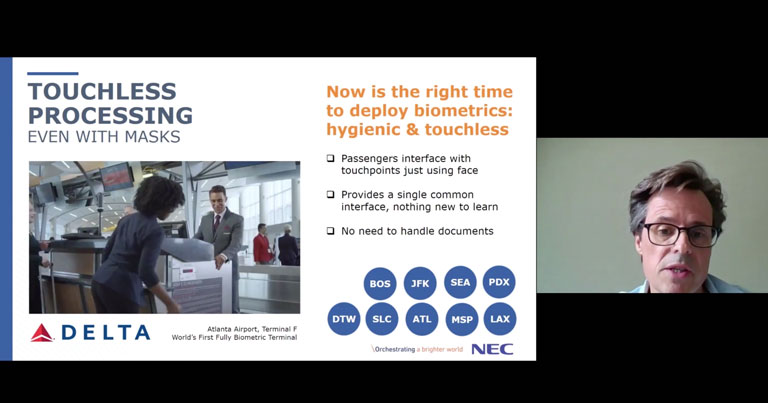
NEC Corporation focused on how airports are implementing touchless technologies like face recognition and thermal sensing for a seamless, hygienic customer experience. Richard Wilks, Director, Global Aviation, NEC, explained that the company is working with its customers and partners to establish low-cost solutions using AI, biometrics and identify management to overcome some of the challenges. “Here at NEC, we believe that now is the right time for biometrics at airports to take centre stage.” Highlighting Delta’s fully biometric terminal, he said that 87% of all outbound Delta international passengers are boarding with their face only at an average verification speed of 1.5 seconds per passenger, allowing Delta to shorten the usual boarding time process. 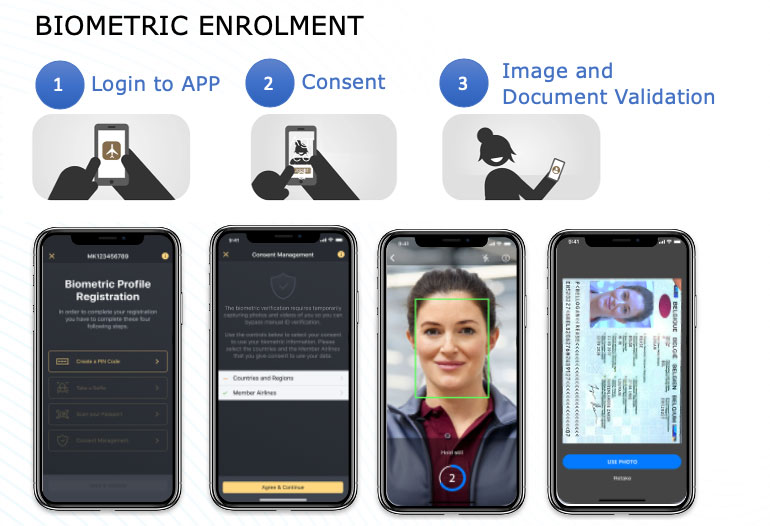 So how can biometrics help in a COVID-19 world? Indeed, biometrics can take one third of the process off the airport. NEC now offers an SDK (Software Development Kit) or a White-Label App for airlines to provide consent-based enrolment into a biometric programme. As part of the enrolment NEC will do an identity match through a selfie or a photo contained within the passport and also authenticate the passport being used. The benefit for the passenger is that once enrolled they no longer need to show their passport or boarding pass at the airport. Wilks also announced that Star Alliance member airlines will be the first to use the service in Europe. Launching in late-summer, Star Alliance’s frequent flyers can enrol permanently into the Star Alliance biometric hub. Once enrolled their biometric identity will travel with them from airport to airport and airline to airline.
So how can biometrics help in a COVID-19 world? Indeed, biometrics can take one third of the process off the airport. NEC now offers an SDK (Software Development Kit) or a White-Label App for airlines to provide consent-based enrolment into a biometric programme. As part of the enrolment NEC will do an identity match through a selfie or a photo contained within the passport and also authenticate the passport being used. The benefit for the passenger is that once enrolled they no longer need to show their passport or boarding pass at the airport. Wilks also announced that Star Alliance member airlines will be the first to use the service in Europe. Launching in late-summer, Star Alliance’s frequent flyers can enrol permanently into the Star Alliance biometric hub. Once enrolled their biometric identity will travel with them from airport to airport and airline to airline.
BAGTAG: Re-thinking baggage check-in

Focusing on digital baggage was Jasper Quak, Managing Director at BAGTAG, who provided viewers with some quick wins to resume operations safely by implementing Electronic Bag Tags. “At BAGTAG we have given the whole situation a lot of thought and we have started working on a White Paper, which is now published, focusing on how we can adapt the current passenger journey, so it is ready for the recovery of air traffic demand,” he said. Recognising that the industry is in need to adapt to the “new normal”, BAGTAG has identified three main building blocks to achieve this – avoiding queuing and crowding; avoiding human and machine interaction; and introducing rapid health checks at airports. “We believe if we put these building blocks together, they form a solution. This solution is aimed at two things – making the passenger journey safe and restoring the passenger confidence.” However, Quak pointed out that the airport check-in and bag-drop processes create bottlenecks, which prevent this vision from becoming a reality. BAGTAG believes that by introducing Electronic Bag Tags (EBT) these issues will be solved by moving passenger check-in fully off the airport. Indeed, some 287 airports worldwide have handled luggage with BAGTAG’s EBTs, including China Southern, Lufthansa, Austrian, Swiss, KLM Royal Dutch Airlines and others. Quak said: “The main message here is that this is not something that is happening tomorrow, but it is already available today. You can implement this technology today to be ready for tomorrow.” Among some of the benefits of the EBTs are that they reduce the need for check-in staff by 50-90%, creating cost-saving opportunities for airlines; remove the need for physical touch points; and provide airports with the opportunity to handle four-times more bags per hour, creating efficiency and more space in the terminal, leading to effective social distancing.
Xovis: Physical distancing at airports
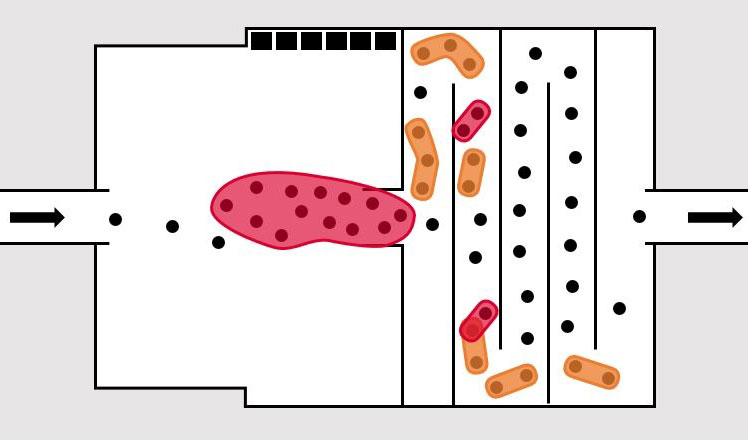
Switzerland-based Xovis says that physical distancing will be a key challenge for airports to deal with, once air traffic resumes. Flurin Hänseler, Research Scientist at Xovis, joined the webinar to present findings from his latest white paper, on ‘How to monitor and ensure physical distancing in crowded spaces’. Tracking crowd movements through a passenger contagion map, as well as identifying contagious groups at an early stage, will be two powerful tools that airports can actively use to ensure they will be compliant with post-COVID-19 travel regulations, and can give returning travellers some peace of mind. “Achieving social distancing at airports is particularly difficult because you have queues at different touchpoints,” said Hänseler. “So we asked ourselves what are the key ingredients we need to measure physical distancing. First we need to measure people flow especially in queue areas. Secondly, we need to be able to calculate distance, and third we need to be able to identify hotspots and areas where the risk of contagion is high. Xovis’ sensors can already measure people flow and calculate distance, so we can take the data from them as we speak. So the main challenge is the identification of contagious areas.” So, by generating a “contagion heat map” over time, airports are able to visually see the areas of interest where passengers are breaching the physical distancing guideline. In terms of areas in the airport, such as check-in and security, the Xovis sensors can be used to generate different contagion maps, focusing on absolute contagion (high contagion risks in busy areas), relative contagion (contagion risk corrected for density), and contagious groups (groups that violate physical distancing).
T&TIS: Social distancing and a V-shape recovery

FTE Startup Hub member T&TIS’ President, Koichi Yano, presented his vision for how the industry can achieve social distancing and a V-shaped recovery. He introduced Airport Point by SMARTRA which can be applied to airports, as well as airlines. Yano explains that passenger stress during travel can be mitigated by travel time prediction. However, it’s not enough to make passengers comfortable. So, T&TIS’ value proposition is to change the stressful time into an enjoyable and beneficial shopping time by using personal travel time prediction. Using the Airport Point system, passengers can minimise their waiting time or effectively use it for other purposes, such as shopping or just relaxing, and obtain other beneficial information, such as timely sale information, based on the predicted passage time. Focusing on how the solution can ensure social distancing, Yano said: “Combined with signs, such as footprints on the floor, this solution lets passengers voluntarily keep the physical distance. It’s important that the system does not force the passengers to keep the physical distance because they would feel uncomfortable when controlled by the authorities unless it is amid a crisis or emergency.”
Dassault Systèmes’ virtual twin technology
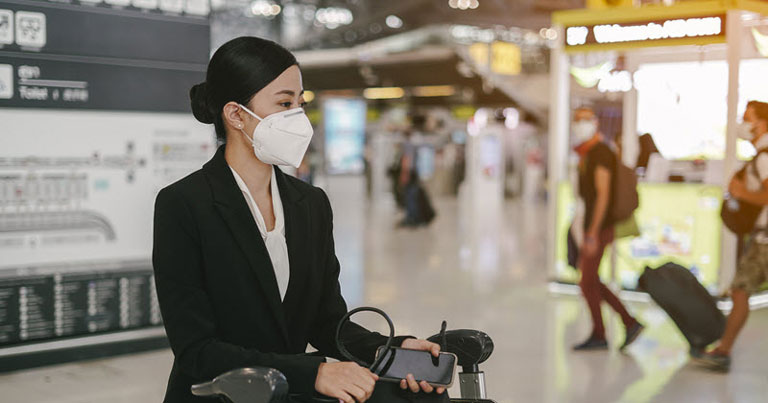
Restoring passenger confidence is one of the key challenges in the post-COVID-19 era, said Isaac Benzaquen, Airport Experience Solution Director, Dassault Systèmes. “Airports are facing many challenges, however it is important that all actions taken by the airport to keep passenger safe are communicated in an efficient manner to build confidence. Quick decision making and stakeholder collaboration are becoming crucial factors to effective change and airports need greater flexibility to adapt to new regulations, and finally we think that airports must assess their operational model to keep costs down. We strongly believe virtual twins can transform how airports can prepare and recover post-COVID-19 and restore passenger confidence.” Benzaquen provided an example of how the company has worked with China’s Central-South Architectural Design Institute (CSADI) to support the simulation and evaluation of virus dispersal in the confined environment of Leishenshan Hospital in Wuhan, China – the largest hospital for infectious diseases and COVID-19 patients. Dassault Systèmes utilised its SIMULIA XFLOW simulation capabilities to simulate virus contamination and diffusion within the hospital’s ventilation system and to counteract the negative effects from unplanned ventilation risks. Additionally, a 3D cloud-based collaborative platform approach replaced an older, slower document-based approach. Dassault Systèmes is able to expand this success story to the airport and create a safe environment for the passenger. Embracing this new Virtual Twin technology will enable airports to achieve their innovation and collaboration goals while keeping passengers safe, healthy, and secure. Using the Virtual Twin’s simulation capabilities, airport teams can perform virtual testing to combat situations like the COVID-19 pandemic with use cases, such as validating the efficiency and effectiveness of open ventilators. The Virtual Twin could also simulate the propagation and exposures of the virus to highlight potential cross-infection areas in the airport and related impacts on passengers and their surroundings.
Copenhagen Optimization’s cloud-based planning solution
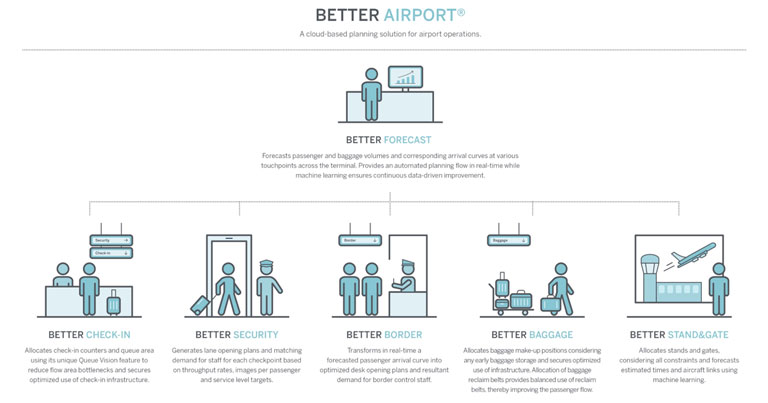
Copenhagen Optimization’s Managing Partner and Co-founder Kasper Hounsgaard addressed how COVID-19 impacts airport operations planning. Copenhagen Optimization is utilising its BETTER AIRPORT platform, a cloud-based planning solution for airport operations. “We have a forecast solution which is looking at passenger flows or baggage flows in real-time operation,” he explained. In terms of how physical distancing is impacting the airport operation, Hounsgaard explained that Copenhagen Optimization has worked with Heathrow Airport over the last two months on implementing physical distancing. Heathrow Airport has condensed its operation into two terminals – Terminal 2 and Terminal 5. Currently, most airlines are in Terminal 2 and in order to comply with physical distancing, check-in desk capacity has been temporarily reduced by 36% due to the proximity of some check-in desks being less than 2 metres. Hounsgaard stressed that the impact of physical distancing must be analysed and planned for. “Queuing is not only about wait time and stickers on the floor, it’s also about compliance with physical distancing.”
Acorel: Providing a safe airport operation
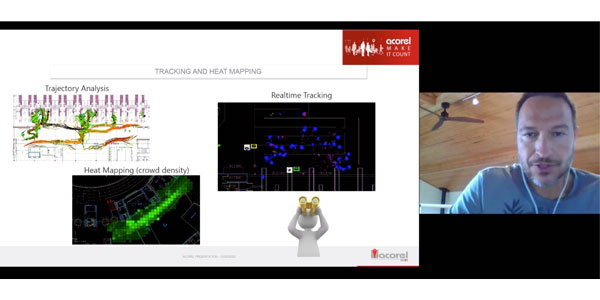
Bruno Aulagner, Business Developer – Airport Solutions, Acorel, shared the company’s vision on how passenger counting can help provide a safe airport operation. Acorel presented two technologies – its LIDAR sensor and 3D stereoscopic sensors. Acorel’s solutions count people with a very high level of accuracy and while it relies on detecting the position of people in real-time, they can also provide trajectory analysis, real-time tracking and heat mapping or crowd density. To tackle social distancing requirements, caused by the COVID-19 outbreak, Acorel is providing turnkey Automatic Passenger Counting Solutions, bringing valuable help to face these challenges. “Our Make it Clean, Make it Fast, Make it Flow and Vision-Lite solutions can truly help airports deal with the post-COVID-19 period.”
Amorph Systems’ Infection Detection and Containment System
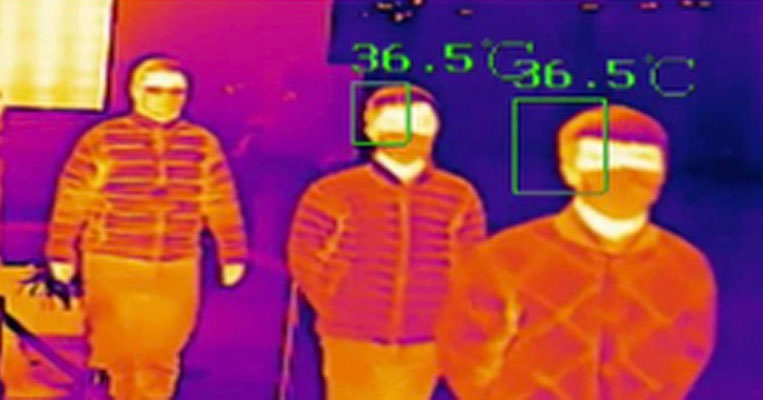
Amorph Systems recently pivoted and teamed up with VANTIQ to help airports worldwide address real-time operational requirements during the COVID-19 outbreak. Andreas Hofmann, Director Business Development Aviation, showcased a brand new solution, a collaborative platform for real-time infection detection and containment for airports, called IDCS (Infection Detection and Containment System). “We are facing a new reality at airports and we think that there would be plenty of measures to check passengers’ health and one of these would be temperature checks to prevent the virus from future spread.” Currently, a lot of airports rely on manual temperature checks and while these are the quickest solution to implement at short-notice, Hofmann pointed out that in the long-run this won’t be efficient enough, as it can create high costs for airports, poses high safety and contamination risks for staff and is incompatible with social distancing measures, leading to high processing times. Once a passenger with fever is detected at the gate, IDCS can individually track the suspect passenger in the airport through the CCTV system and point the security or medical staff to them. “We implemented several features as part of the fever detection system, which are required, such as fever detection, but also location determination, so that airports can detect where the fever event actually is positioned in the airport terminal, as well as a point-to-point tracking which is required to identify where the passenger is. In addition to that there are also all kinds of alerts and notifications to inform the right people across the terminal environment.” Hofmann also added that the solution is designed for collaborative use, so that all stakeholders at the airport can be informed in real-time which action to take.
Elenium Automation’s touchless technology
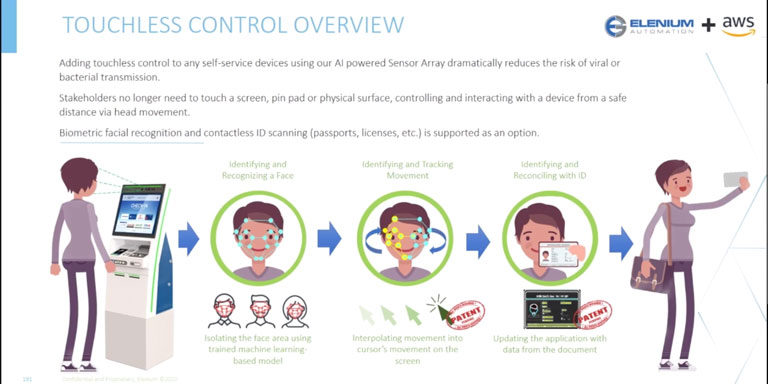
One of the key trends that have emerged following the coronavirus outbreak is around touchless technology. Elenium Automation’s CEO Aaron Hornlimann explained that the company has taken a multi-faceted approach to touchless technology, which includes voice recognition, touchless control, as well as contactless ID scanning. Touchless control can be added to any self-service devices using artificial intelligence and it has the potential to dramatically reduce bacterial transmission. Elenium has developed patent pending touchless solutions allowing passengers, including those with reduced mobility, to control the self-service device using their head movement as an alternative to physically touching a screen. Another benefit of the solution is that it can read and identify ID such as passports. Voice recognition, which Elenium has developed in partnership with Amazon Web Services, is an additional option for touchless control of a self-service device. Hornlimann also explained that the voice recognition can distinguish voices in busy environments like airports, hospitals, or medical centres. In terms of vital sign detection, the process is more than looking at the thermal image, it also features heart rate, body temperature and respiration rate, which are read and analysed using near infrared and thermal imaging to provide an indication of possible illness. Key questions, such as travel history, can be asked to further determine whether escalation to an agent, via video conference, for further assessment is required. This technology is not designed or intended to diagnose medical conditions but provides an early warning indicator. “When we bring all of these technologies together, we are effectively able to work a risk profile for the passenger. It’s important to know that this technology is not designed to diagnose medical condition, but provide an early warning indicator.” Etihad become the first airline to trial Elenium’s new contactless self-service technologies, while Avalon Airport is also set to implement these technologies, becoming the first in Australia to do so.
Vision-Box’s Seamless Flow solutions
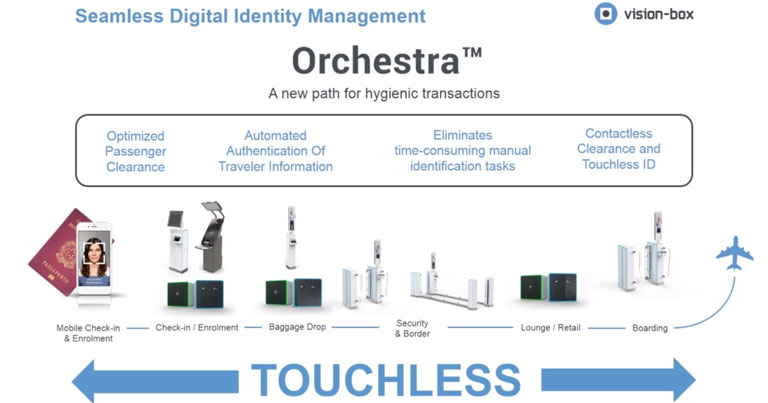
Vision-Box recently published a white paper on the potential of contactless digital identity technology with advanced biometrics to save lives by clearing people quickly and seamlessly at checkpoints in travel hubs and border crossings to prevent physical interaction with potentially infected devices, personnel or surfaces. “Seamless identification technology can help prevent the transmission of pathogens at airports,” Jeff Lennon, Head of Strategic Sales & Global Partnerships, Vision-Box, explained during the FTE APEX webinar. By eliminating the need to exchange travel documents, speeding clearance, reducing crowd levels and lineups, and providing easily-disinfected solutions, Vision-Box’s biometric offerings can minimise the risk at travel hub hotspots, as well as the risk of transmission beyond the travel hub or border area. According to the white paper, current airport operational models could pose a risk of virus transmission, while Seamless Flow solutions leveraging facial biometrics and digital mobile ID apps that have already been gaining momentum may be the new normal as touchless technology is deployed to eliminate bottlenecks and other situations posing increased transmission risk. “Through biometrics, we will be able to know in advance who is coming where, and ultimately this data is available to different stakeholders, based on legitimate purposes they might have to obtain this information for the passenger. Airlines and airports might start real-time information sharing to better rearrange almost in real-time the operation at the airport. And that’s where the combination of orchestration, identity management platform, usage of biometrics and floor management comes together with a combination of technologies from our colleagues such as Xovis and Copenhagen Optimization,” said Lennon.
LB Foster: Customer information systems
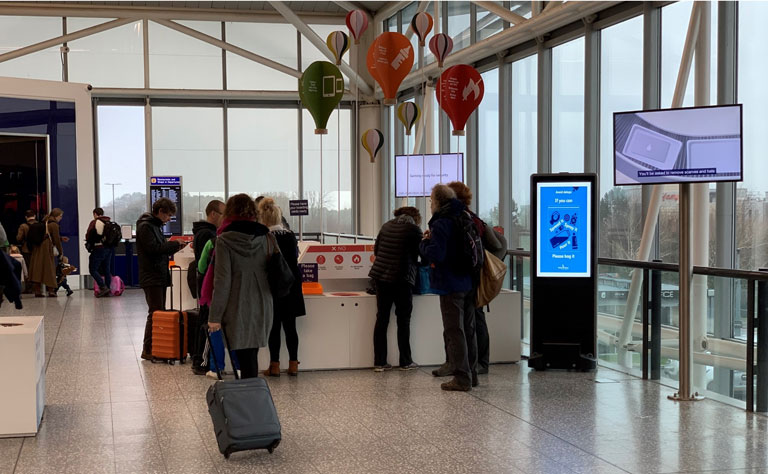
As the coronavirus outbreak develops, Dr Mark Aston, Chief Technology Officer, LB Foster, said that keeping passengers informed in the airport terminal is paramount. He introduced the company’s Inform wireless mobile totem, which is capable of connecting to any passenger information system, as well as operational management systems and disruption messaging. “This is a key technology at this time where the actual footfall through airports, stations and shopping malls need to be managed in a very unusual way,” Aston said. “Social distancing has meant that we need to take into account how displays are used and our totems are very much the idea behind a portable solution that allows you to provide messages that are key to the environment that the passengers are transiting through at that very moment.” The displays are linked wirelessly and can be used at various points at the airport, such as the gates or car parks to prepare people for the journey through the airport itself. The screens have already been used throughout the UK at airports such as Gatwick and Bristol, and rail stations for key messages such as social distancing and prompting people to wash their hands. “We have a global solution to help manage footfall through the terminals and the gates, as the coronavirus impacts air travel and airport travel itself,” explained Aston.
DUBZ: Airport of the future
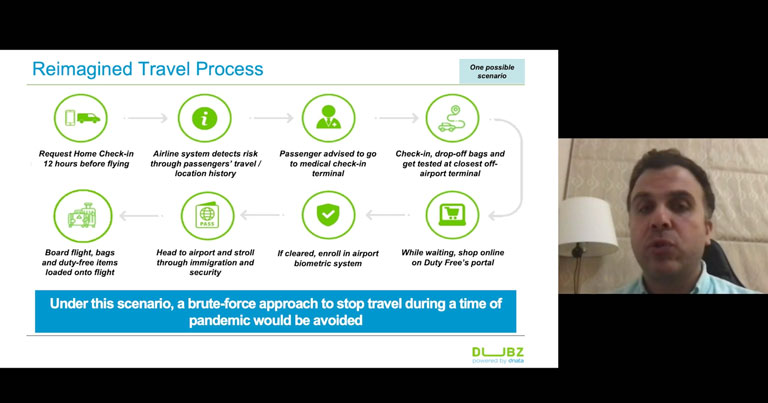
Omar Abou Faraj, CEO & Co-founder, DUBZ, took the opportunity to lay out a vision for the airport of the future. He said: “We want to change how things work at the airport. Legacy systems have been implemented at airports and we believe if we digitise these we can bring a lot of operational and commercial benefits and enhance the passenger experience.” Building on its project in Dubai, where DUBZ opened a check-in station in The Dubai Mall for airline passengers travelling through Dubai International Airport, the company now wants to expand this service globally. “We have customised technology for offsite processing and operational know-how particularly when it comes to taking the airport processes offsite.” In a recent White Paper, published by DUBZ, Faraj argues that the process of travel as we know it today plays a key role in making the whole process more vulnerable. The key concept behind it is decentralising the airport processes or bringing key airport processes off-airport. During his presentation he proposed one scenario of travelling, in which the passenger can be screened for potential risk prior to arriving at the airport. The airline system can view the passenger’s full travel and personal history, which is securely stored. Prior to checking-in the passenger, the system detects that based on his/her location over the previous few days there is a heightened risk of having been infected by a recent disease, such as COVID-19. The passenger can then be advised to go to a remote and mobile check-in terminal that is quipped with a medical check-up facility, where they would spend a few hours in isolation while waiting for the test results. Faraj explained that this isolation room doesn’t need to create a stressful experience for the passenger, but in fact could serve as a duty-free and entertainment portal. If medically fit, the passenger can then receive immigration clearance using biometrics and board the flight. So, by implementing this type of passenger journey, DUBZ says it can enable implementation of early processing of passengers; use predictive analytics to identify those at risk; reduce interaction time as well as crowds at the airports; and meet health and security standards, while maintaining an excellent passenger experience.
Among the highlights during the event was also a panel discussion between Christina Cassotis, CEO, Pittsburgh Airport; Javed Malik, Group COO, AirAsia; and Joe Leader, CEO, APEX/IFSA, who focused on how collaboration and technology will be instrumental to building confidence in the industry. Read our coverage here.






